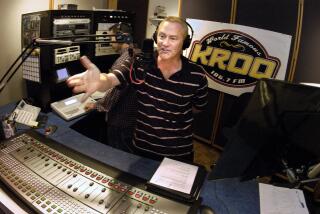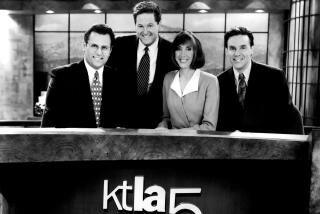Country music fans warm up to KKGO
- Share via
Go Country 105 broke strong from the starting gate, according to initial ratings, and grateful country-music fans could keep it on the air and in the black for a long time, observers say.
KKGO-FM (105.1) premiered Feb. 26, filling a void left when country station KZLA-FM (93.9) changed formats in August after 25 years -- a switch that left most Southland fans without a radio outlet for the likes of Tim McGraw and Toby Keith.
KKGO started broadcasting country music at 1260 on the AM dial four months after KZLA rode off into the sunset, then swapped frequencies with sister KMZT, classical station K-Mozart, and took its twang to FM.
In Arbitron survey results released last week, KKGO rose from .6% of the L.A.-Orange County listening audience ages 12 and up to .8% between the last quarter of 2006 and the first three months of 2007.
But the results were more dramatic than they appear: The frequency change came two-thirds of the way through the ratings period; in March alone, KKGO’s first full month on FM, it registered a 1.9% audience share. That bettered the 1.7% that KZLA averaged in its last full ratings period, spring 2006.
“I’m absolutely thrilled. The country just went wild,” said Saul Levine, owner of both KKGO and KMZT. “We’re so delighted we made the switch.”
“I think they’re being overwhelmed with positive responses,” said R.J. Curtis, former program director of KZLA and now country music editor of the trade publication Radio & Records. “I know the listeners are pumped. You don’t know how much you love something until it’s gone.”
And even though a month’s worth of numbers is a small indicator, the bump for KKGO is “a huge, encouraging sign,” said Lon Helton, host of the syndicated “Country Countdown USA,” a country-radio broadcaster since 1971 and former president and chairman of the Country Music Assn.
“The numbers they got are no surprise to me. The station wasn’t even hitting on all cylinders when that happened. They should be able to attract, at minimum, the same audience KZLA did.”
Promotion efforts
Curtis noted that the early ratings gain came in spite of scant promotion. Now KKGO is making itself more visible, including bus advertising, concert sponsorships and a presence at this weekend’s massive Stagecoach festival in Indio.
In addition, Helton said KKGO will have the full support of Nashville, which recognizes that Los Angeles is the nation’s largest market for country music CDs.
“When the announcement was made that KZLA was going away, the pain was felt here,” Helton said from Nashville. “It’s Los Angeles -- to have a market that size without a country music station, it kind of says something about the format. It’s not good.”
KKGO is playing it smart, Helton and Curtis said, by both embracing and distancing itself from its predecessor.
Levine has populated the station’s schedule with familiar voices from KZLA, such as hosts Shawn Parr, Tonya Campos and Whitney Allen. But, while KZLA had a tight playlist skewed heavily to the latest hits, KKGO bills itself as “today’s hits and yesterday’s favorites.”
“If you’re going to launch a radio station, it shouldn’t be a clone of what was on before,” Curtis said. Besides, “not everybody loved what we were doing. A lot of people thought we didn’t play enough old music.”
Now, alongside today’s hit makers Kenny Chesney and Carrie Underwood, KKGO is playing classic artists such as Chris LeDoux, Merle Haggard, Waylon Jennings, Patsy Cline and Willie Nelson.
HD hopes
The other side of the KKGO station swap, KMZT, didn’t fare as well, dropping from 1.5% to 1% of the local audience from the fall to the winter ratings period, which ran from Jan. 11 to April 4. But Levine joked he’s happy that KMZT kept any audience at all, after doomsayers said classical music fans would reject the lesser fidelity of the AM band.
“I’m just asking the community to give us a chance. We’re hoping people will open their minds,” he said.
He’s also pinning his hopes on increased acceptance of HD radio, a technology that lets listeners with the advanced equipment get digital AM signals that sound like FM, and FM signals of CD quality. It also lets broadcasters send parallel music streams from the same frequency, so the secondary HD signal from KKGO-FM is a high-fidelity simulcast of KMZT.
KZLA’s parent company, Emmis Communications, dumped the country format because it saw more advertising sales potential with the “rhythmic adult contemporary” on its successor, KMVN-FM, which now plays the Black Eyed Peas and Justin Timberlake.
But the $20 million in annual revenue from a country station that wasn’t enough for Emmis is quite an upgrade for Levine, who said he made $5 million last year with KMZT when it was on FM.
Helton said those figures should give comfort to country music fans -- the money appears enough to keep independent-operator Levine content with the format yet not enough to lure a major corporate competitor that could take down KKGO.
“He can certainly make that work. He isn’t feeding a nationwide company,” Helton said.
“Let’s face it, country music radio is a niche. A very large niche,” he said, but it’s not going to reach the ratings heights of a Top 40 station such as KIIS-FM (102.7) or an adult contemporary outlet such as KOST-FM (103.5). They placed second and sixth, respectively, in the most recent ratings.
“It’s not ever going to be that, so let’s get over that. But it can deliver a huge audience,” Helton said.
More to Read
The biggest entertainment stories
Get our big stories about Hollywood, film, television, music, arts, culture and more right in your inbox as soon as they publish.
You may occasionally receive promotional content from the Los Angeles Times.










